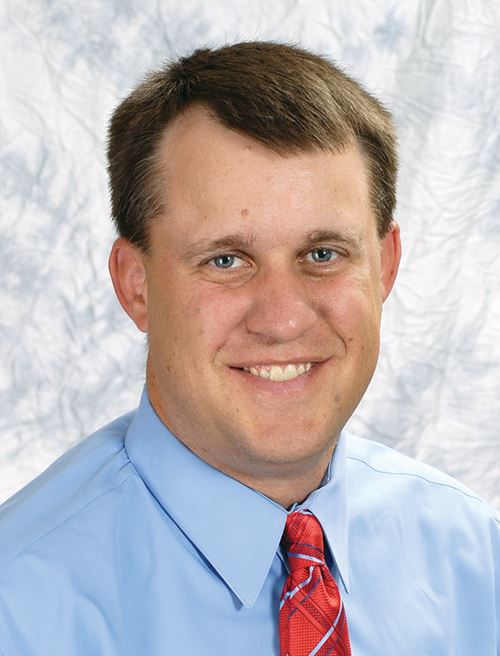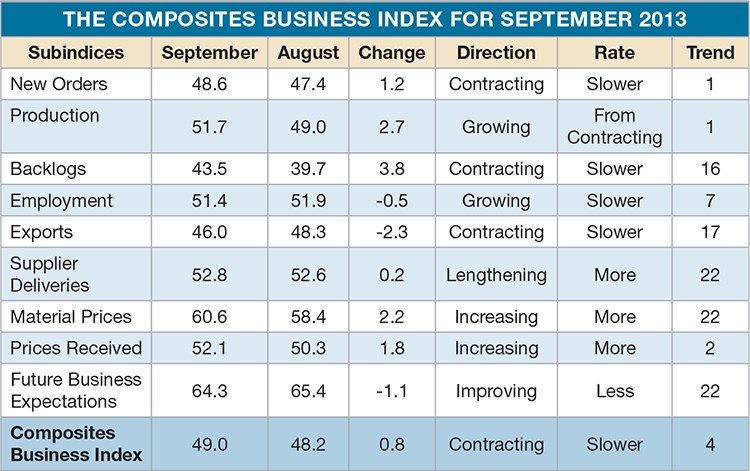Composites Business Index 49.0: Contraction slows again
Gardner Business Media’s (Cincinnati, Ohio) director of market intelligence Steve Kline, Jr. updates the Composites Business Index for the November issue of HPC.
In August, a Composites Business Index of 48.2 showed that composites business activity had contracted for a third consecutive month, but at a slower rate, indicating a possible break with its downward trend. Two subindices made positive contributions: Employment grew for the sixth straight month, and suppler deliveries continued their long-term lengthening trend. Production and exports continued to contract, but did so at slower rates. Exports, in particular, had contracted at a steadily slower rate since December 2012. New orders contracted for the fourth consecutive month. The only subindex to negatively impact the CBI was backlogs. In August, it contracted for the 15th month and had done so faster each month since February.
Material prices increased in August at their slowest rate since November 2012. Prices received increased slightly after decreasing three of the previous four months. Future business expectations fell a bit after leveling for six months.
One month does not a trend make, but August activity based on plant size appeared to shift. Fabricators with 250+ employees contracted for the first time since November 2012. Those with fewer than 19 employees continued to contract, but at a much slower rate. The small facility index, however, moved up to 43.9 from 38.9 in July. Those with 50-249 employees continued strong.
Four regions expanded in August. The fastest rate was in West South Central, which had grown five of the previous seven months. Meanwhile, New England, the South Atlantic and the Middle Atlantic all moved from contraction to expansion. But the West North Central, which had strong growth the previous five months, fell off sharply.
Future capital spending plans were just above the historical average.
Gardner’s September CBI, 49.0, showed that business activity contracted at a slower rate for the second consecutive month. But September still marked a fourth consecutive month of contraction.
Four of the six subindices made positive contributions to the overall CBI in September. The largest jump came in the backlogs, which moved to 43.5 from 39.7. However, backlogs have contracted since May 2012. Production also jumped significantly to growth from contraction. Production has grown seven of the nine months this year. New orders reached its highest level since May. Also positive was supplier deliveries, which lengthened slightly. Employment grew for the seventh consecutive month but at a slightly slower rate. This had a slightly negative impact on the overall index. The worst performer was exports, which dropped to 46.0 from 48.3. Exports have contracted for 17 months.
Material prices increased at a faster rate in September, but the rate of increase was the second slowest since November 2012. Prices received by composite fabricators jumped to 52.1 from 50.3. This was the second month in a row that prices received increased at a faster rate. Future business expectations fell slightly but were still above the lower levels recorded in the second half of 2012.
After contracting in August, fabricators with more than 250 employees grew in September. Facilities with 100 to 249 employees continued strong, growing their fastest rate since July 2012. Fabricators with fewer than 100 employees contracted in September. Facilities with 50 to 99 employees contracted for the second time in 2013. Fabricators with 20 to 49 employees saw their best business conditions since March, this year.
Two regions, the West South Central and the Middle Atlantic, grew for the second month in a row. New England and the South Atlantic moved from growth to contraction. The East North Central, Pacific, and West North Central contracted, again, but at a slower rate.
Future capital spending plans were at their lowest level since March 2013. However, planned expenditures were 11 percent higher than in September 2012.
Read Next
Plant tour: Daher Shap’in TechCenter and composites production plant, Saint-Aignan-de-Grandlieu, France
Co-located R&D and production advance OOA thermosets, thermoplastics, welding, recycling and digital technologies for faster processing and certification of lighter, more sustainable composites.
Read MoreVIDEO: High-volume processing for fiberglass components
Cannon Ergos, a company specializing in high-ton presses and equipment for composites fabrication and plastics processing, displayed automotive and industrial components at CAMX 2024.
Read More“Structured air” TPS safeguards composite structures
Powered by an 85% air/15% pure polyimide aerogel, Blueshift’s novel material system protects structures during transient thermal events from -200°C to beyond 2400°C for rockets, battery boxes and more.
Read More
.JPG;width=70;height=70;mode=crop)










.jpg;maxWidth=300;quality=90)






